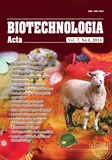ISSN 2410-7751 (Print)
ISSN 2410-776X (Online)

"Biotechnologia Acta" v. 7, no 4, 2014
https://doi.org/10.15407/biotech7.04.049
Р. 49-53, Bibliography 17, English
Universal Decimal classification: 663.12: 575.224.4: 577.161.1
ISOLATION OF Phaffia rhodozyma YEASTS MUTANTS UNDER INCREASED CAROTENOID CONTENT
Matselyukh B. P. 1, Matselyukh D. Ya. 1, Golembiovska S. L. 1, Gural S. V. 2
1Zabolotny Institute of Microbiology and Virology of the National Academy of Sciences of Ukraine, Kyiv
2Institute of Animal Biology of the National Academy of Agrarian Sciences of Ukraine, Lviv
The aim of the paper was the selection of the improved strains of Phaffia rhodozyma using chemical mutagenesis and the identification of individual carotenoids synthesized by isolated more pigmented mutants. Hyperpigmented mutants of P. rhodozyma NRRL Y-17268-1 and IMB Y-5021-15 were isolated from initial strains NRRL Y-17268 and IMB Y-5021 by nitrosoguanidine mutagenesis. Pigments were purified by TLC and identified using HPLC and liquid chromatography-mass spectrometry. It was shown that initial strains P. rhodozyma NRRL Y-17268 and IMB Y-5021 and obtained from them mutants NRRL Y-17268-1 and IMB Y-5021-15 produced torulene and torularhodin without illumination in shaking flasks at 20 оC. The content of torularhodin produced by the mutant strains Y-17268-1 (18.2 ?g) and Y-5021-15 (16.5 ?g) per 1.0 g of dry biomass was increased to 33.8 and 18.4%, respectively, in comparison with the content of this pigment in the initial parental strains. The obtained strains present interest for further selection of more active producers of carotenoids and examination of the action of reactive oxygen species as stimulators of carotenoid production in yeasts.
Key words: Phaffia rhodozyma, mutagenesis, torulene, torularhodin.
© Palladin Institute of Biochemistry of the National Academy of Sciences of Ukraine, 2008
References
1. Methods in Enzymology. Steroids and Isoprenoids. Part B. Ed. by Law J. H., Rilling H. C. Acad. Press: Orlando, San Diego, New York, London, Toronto, Montreal, Sydney, Tokyo. 1985, V. 111, P. 190.
2. Johnson E. A. Phaffia rhodozyma: colorful odyssey. Int. Microbiol. 2003, V. 6, P. 169–174.
https://doi.org//10.1007/s10123-003-0130-3
3. Frengova G. I., Beshkova D. M. Carotenoids from Rhodotorula and Phaffia: yeasts of biotechnological importance. J. Industr. Microbiol. Biotechnol. 2009, 36(2), 163–180.
https://doi.org/10.1007/s10295-008-0492-9
4. Schmidt I., Schewe H., Gassel S. Biotechnological production of astaxanthin with Phaffia rhodozyma/Xanthophyllomyces dendrorhous. Appl. Microbiol. Biotechnol. 2011, V. 9, P. 555–571.
https://doi.org/10.1007/s00253-010-2976-6
5. Gural S. V., Kolysnyk G. V., Klymyshyn D. O., Gonchar M. V. Investigation of carotenoids composition in the yeast mutants Phaffia rhodozyma (Xanthophyllomyces dendrorhous). Biotekhnolohiia. 2011, 4(1), 93–100. (In Ukranian).
6. Weber R. W., Anke H., Davoli P. Simple method for the extraction and reversedphase highperformance liquid chromatographic analysis of carotenoid pigments from red yeasts (Basidiomycota, Fungi). J. Chromatogr. A. 2007, V. 1145, P. 118–122.
https://doi.org/0.1016/j.chroma.2007.01.052
7. Foncesa R. A., Rafael R. S., Kalil S. J., Burkert CAV., Burkert J. F. Different cell disruption methods for astaxanthin recovery by Phaffia rhodozyma. Afr. J. Biotechnol. 2011, 10 (7), 1165–1171.
8. Nghiem N. P., Montanti L., Johnston D. Production of astaxanthin from corn fiber as a valueadded coproduct of fuel ethanol fermentation. Appl. Biochem. Biotechnol. 2009, V. 154, P. 227–237.
https://doi.org/10.1007/s12010-008-8399-5
9. Parajo J. C., Santos V. V., Vazque M. Production of carotenoids by Phaffia rhodozyma growing on media made from hemicellulosic hydrolysates of eucalyptus globulus wood. Biotechnol. Bioeng. 1998, 59 (4), 501–506.
https://doi.org/0.1002/(SICI)1097-0290(19980820)59:4<501::AID-BIT13>3.0.CO;2-C
10. Vazques M., Santos V., Parajo J. C. Effect of the carbon source on the carotenoid profiles of Phaffia rhodozyma strains. J. Ind. Microbiol. Biotechnol. 1997, 19 (4), 263–268.
https://doi.org/10.1038/sj.jim.2900376
11. Vazquez M., Santos V., Parajo J. C. Fedbatch cultures of Phaffia rhodozyma in xylosecontaining media made from wood hydrolysates. Food Biotechnol. 1998, 12 (1, 2), 43–55.
12. Polulyakh O. V., Podoprigora O. I., Eliseev S. A. Biosynthesis of torulene and torularhodin in the yeast Phaffia rhodozyma. Prikladnaya biochimia i mikrobiologiya. 1991, 27 (4), 541–545. (In Russian).
13. Buzzini P., Innocenti M., Turchetti B. Carotenoid profiles of yeasts belonging to the genera Rhodotorula, Rhodosporidium, Sporobolomyces, and Sporidiobolus. Can. J. Microbiol. 2007, 53 (8), 1024–1031.
https://doi.org/10.1139/W07-068
14. Davoli P., Mierau V., Weber R. W. S. Carotenoids and fatty acids in red yeasts Sporobolomyces roseus and Rhodotorula glutinis. Prikladnaya biochimia i mikrobiologiya. 2004, 40 (4), 460–465. (In Russian).
15. Ferdes M., Ungureanu C., Mihalcea A. The influence of the carbon source on torularhodin pigment biosynthesis. Rev. Chim. (Bucharest). 2011, 62 (3), 339–343.
16. Schroeder W. A., Johnson E. A. Singlet oxygen and peroxyl radicals regulate carotenoid biosynthesis in Phaffia rhodozyma. J. Biol. Chem. 1995, 70 (31), 18374–18379.
https://doi.org/10.1074/jbc.270.31.18374
17. Matselyukh B. P., Matselyukh D. Ya., Golembiovska S. L. Isolation of Streptomyces globisoporus and Blakeslea trispora mutants with increased carotenoid content. Mikrobiol.Zh. 2013, 75 (6), 10–16.

